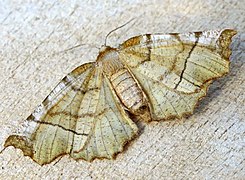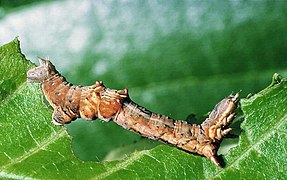Three-lined moonspot tensioner
| Three-lined moonspot tensioner | ||||||||||||
|---|---|---|---|---|---|---|---|---|---|---|---|---|

Three-lined moon-spotted wrench ( Selenia dentaria ), underside of the wing male |
||||||||||||
| Systematics | ||||||||||||
|
||||||||||||
| Scientific name | ||||||||||||
| Selenia dentaria | ||||||||||||
| ( Fabricius , 1775) |
The three-striped moon spot spanner ( Selenia dentaria ) is a butterfly ( moth ) from the spanner family (Geometridae). In the literature, the species is sometimes found as Selenia bilunaria , Geometra illunaria or Phalaena bilunaria .
features
butterfly
The moths reach a wingspan of 34 to 45 millimeters. Second generation copies are smaller. There is no difference in color between the sexes. The wing edges are jagged. The basic color of the wings varies from yellow-gray to light brown to reddish brown. On the upper side of the forewing, three dark brown transverse lines stand out, which continue only in a weakened manner on the hind wings. In the fringe area below the apex , a large brown crescent moon spot can be seen, which is laid out whitish. A discal stain is missing. On the mostly dark, red-brown undersides of the wings, in addition to the broad transverse bands, small arrow-shaped or crescent-shaped white spots in the disk region stand out . The antennae of the males are strongly double ciliate, those of the females are short sawtooth.
egg
The egg is matt and has an elongated oval shape. It is slightly indented on the sides. The shell structure is network-like and has tiny warts at the nodes. Freshly laid eggs have a brownish yellow color that turns carmine red shortly before the caterpillars hatch. The micropyl rosette has 14 leaves.
Caterpillar
Adult caterpillars are very variable in color and can appear in black-brown, reddish-brown or cream-colored specimens. The sixth body segment shows two parallel, short dark brown stripes on the back. On the seventh and eighth body segments, two distinct humps stand out, which gives them the appearance of a small twig with buds and thus represents an excellent camouflage.
Doll
The pupa is red-brown in color, the wing sheaths are black-brown. The cremaster is button-shaped and shows two long hooked bristles in the middle and several short hooked bristles on both sides.
Similar species
The middle transverse line is missing or only weakly indicated in the case of the two- striped moon spot spanner ( Selenia lunularia ) and the purple-brown moon spot spanner ( Selenia tetralunaria ).
distribution and habitat
The three-lined moonspot spanner is widespread in Europe up to the Urals . It is also found in Siberia , Kamchatka , Mongolia and northern China . The main habitat are light deciduous forests, bushy heaths, moors, riparian areas as well as gardens and parks. In the Alps , the species rises to around 2000 meters.
Way of life
The moths are nocturnal and fly in two generations, mainly in the months of April and May as well as July and August. In the higher altitudes of the Alps, only one generation is formed, which flies in June and July. They appear at night in artificial light sources . During the day they rest in the vegetation with half-spread wings. The caterpillars feed polyphagously on the leaves of various hardwoods, for example linden ( Tilia ), elm ( Ulmus ), oak ( Quercus ), birch ( Betula ), willow ( Salix ), hawthorn ( Crataegus ) and honeysuckle ( Lonicera ). The food plants also include raspberries ( Rubus idaeus ) and blueberries ( Vaccinium myrtillus ). The second generation overwinters in the pupal stage .
Danger
The three-striped moon spot spanner is widespread in all German federal states, sometimes in large numbers and is classified as "not endangered" on the Red List of Endangered Species .
Individual evidence
- ↑ a b Peder Skou & Pasi Sihvonen. In: Axel Hausmann (Ed.): The Geometrid Moths of Europe, Volume 5: Subfamily Ennominae I , Brill, Leiden, 2015, ISBN 978-90-04-25220-2 , pp. 286-289
- ^ A b c Walter Forster , Theodor A. Wohlfahrt : The butterflies of Central Europe, Volume 5, Spanner. (Geometridae). Franckh'sche Verlagshandlung, Stuttgart 1981, ISBN 3-440-04951-5 , p. 212
- ↑ Manfred Koch , Wolfgang Heinicke, Bernd Müller: We determine butterflies. Volume 4: Spanner. 2nd improved and enlarged edition. Neumann, Leipzig / Radebeul 1976, DNB 780451570 , pp. 204/205
- ↑ flight times
- ↑ a b Günter Ebert (Ed.): The butterflies of Baden-Württemberg. 1st edition. Volume 9. Moths VII. Geometridae 2 Ulmer, Stuttgart (Hohenheim), 2003, ISBN 3-8001-3279-6 , pp. 396-399
- ↑ Endangerment
literature
- Peder Skou & Pasi Sihvonen. In: Axel Hausmann (Ed.): The Geometrid Moths of Europe, Volume 5: Subfamily Ennominae I , Brill, Leiden, 2015, ISBN 978-90-04-25220-2
- Günter Ebert (Ed.): The butterflies of Baden-Württemberg. 1st edition. Volume 9. Moths VII. Geometridae 2nd part. 1 Ulmer, Stuttgart (Hohenheim), 2003, ISBN 3-8001-3279-6
- Walter Forster , Theodor A. Wohlfahrt : The butterflies of Central Europe, Volume 5, Spanner. (Geometridae). Franckh'sche Verlagshandlung, Stuttgart 1981, ISBN 3-440-04951-5 .
Web links
- Lepiforum e. V. - Taxonomy and photos
- kolumbus.fi - caterpillar
- britishlepidoptera - British Lepidoptera
- ukmoths - Early Thorn at UKmoths
- pyrgus.de - Butterflies and their ecology
- funet.fi - dissemination
- fauna-eu - Fauna Europaea




